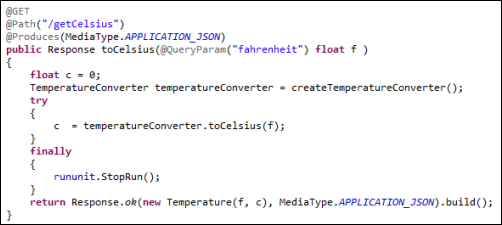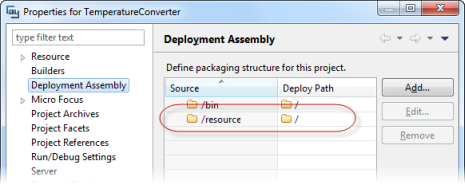The EJB Project - TemperatureConverterEJB
The following steps show the features required in order to deploy it alongside the other two projects.
- In the
Navigator pane, navigate to
and double-click
TemperatureConverterBean.java.
The Java class appears.
-
This is the EJB class, as denoted by the @Stateless annotation. It imports the com.microfocus.cobol.runtimeservices API, which provides the Micro Focus RunUnit class. The following code shows a TemperatureConverter instance being wrapped in a RunUnit. Each instantiated RunUnit contains its own resources to allow it to run independently of other RunUnit instances, thus enabling the application to provide a multi-user environment.
import com.microfocus.cobol.runtimeservices.*; ... private TemperatureConverter createTemperatureConverter() { rununit = new RunUnit(); TemperatureConverter tempConverter = new TemperatureConverter(); rununit.Add(tempConverter); return tempConverter; } - The RunUnit syntax includes a
try...finally block containing a call to the
StopRun method, ensuring that the resources used by the JVM COBOL are freed up when required, even in the event of an exception.
... TemperatureConverter temperatureConverter = createTemperatureConverter(); try { c = temperatureConverter.toCelsius(f); } finally { rununit.StopRun(); } ... - In the
Navigator pane, navigate to
and double-click
ITemperatureConverter.java.
The interface implemented by the previous class appears.
- The interface imports the
JAX-WS-RS API to create a RESTful application. This can be seen by the annotations (@GET, @Path, @Produces) used throughout the TemperatureConverterBean class. For example, the following
toCelsius method uses the annotations to configure how the request is handled:
The annotations help to build the URL that forms the request in the deployed application. The return phrase indicates that the response to the client will be returned in JSON format using a simple Temperature class.
- In the
Navigator pane, navigate to
and double-click
Temperature.java.
The class is annotated with @XmlRootElement (name = "Temperature" ), which allows the build() API to use reflection on the class to build up the JSON output based on the fields and their values. The build() method then adds the appropriate header information to pass back to the client.
- In the
Navigator pane, navigate to
and double-click
TemperatureConverterApp.java.
This is the wrapper class that enables the EJB to be deployed to the application server.
@ApplicationPath("/") public class TemperatureConverterApp extends javax.ws.rs.core.Application { @Override public Set<Class<?>> getClasses(){ Set<Class<?>> s = new HashSet<Class<?>>(); s.add(TemperatureConverterBean.class); } }By extending the JAX-WS-RS API this time, it uses the getClasses() method to register the TemperatureConverterBean EJB class with the application server, as a REST web service.
- In the
Navigator pane, navigate to
.
As with the JVM COBOL project, this project contains a cobconfig.properties file configured in the same way. If one does not exist, use the options to add a new resource file.
- You must ensure that cobconfig.properties is deployed as part of the project:

